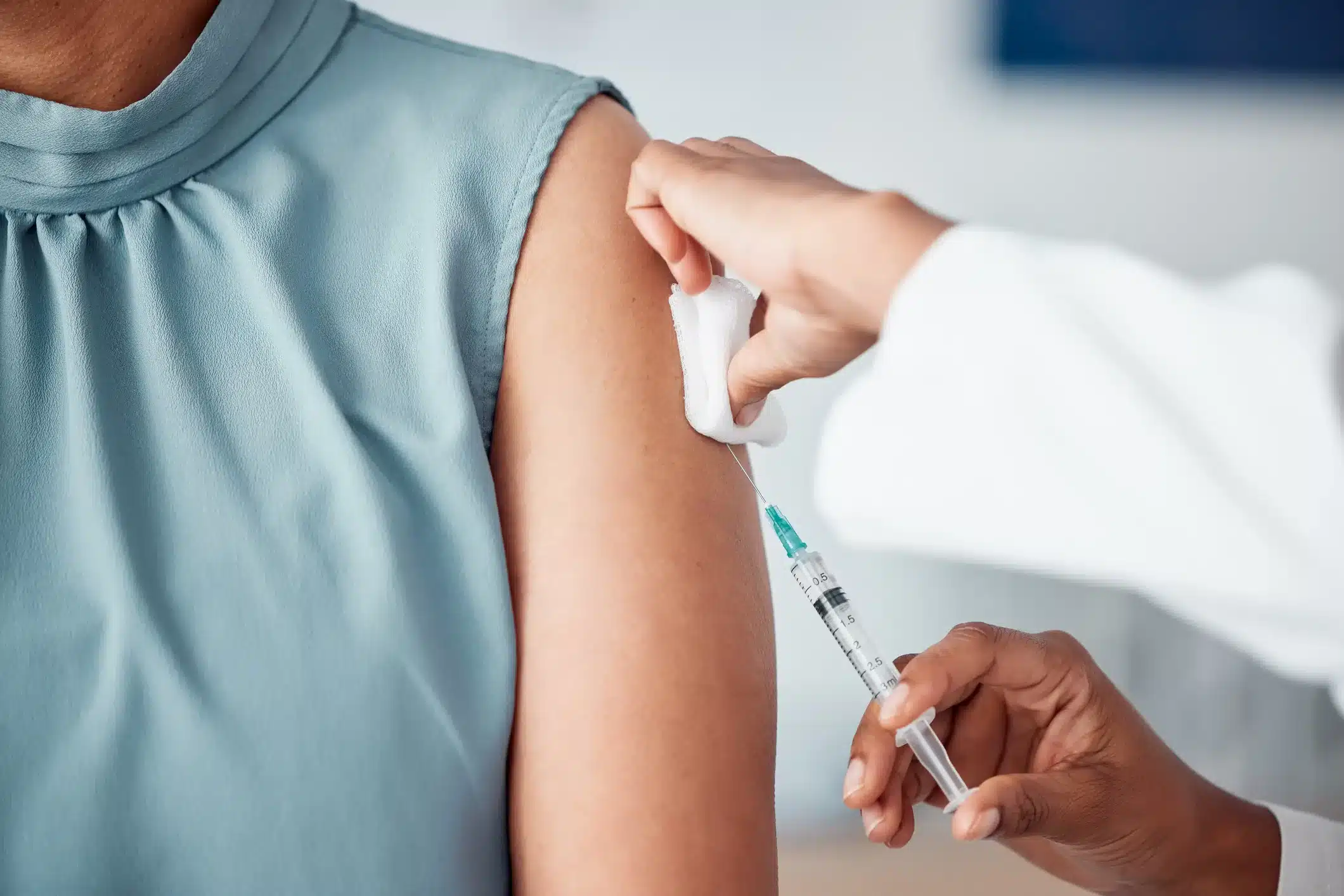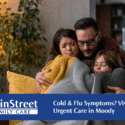
Your trusted friends at MainStreet Family Care share the facts about vaccine safety to keep you and your family healthy.
The internet and media are full of information that can be misleading or even downright false and dangerous. Over the last 20 to 30 years, several scary myths about vaccines have developed and may have you worried about your health and the health of your family.
Before we bust these vaccine myths with scientific evidence, let’s briefly talk about what vaccines are and how they protect us by preventing infectious diseases.
Vaccine Facts
Vaccines are medications designed to teach your immune system how to fight against specific bacteria and viruses to prevent the potentially life-threatening diseases they cause. Vaccines work by helping your body form an immune response against vaccine-preventable diseases.
Vaccine Safety
The Centers for Disease Control (CDC) is the federal agency in the United States responsible for our nation’s health security through disease control and prevention. The CDC works with the National Institutes of Health (NIH) to rigorously study and test the safety and effectiveness of vaccines for vaccine-preventable diseases before the Federal Drug Administration (FDA) approves them.
To ensure vaccine safety, the CDC monitors the effectiveness of all vaccines and investigates any reports of adverse reactions. The CDC reports less than one adverse reaction for every one million vaccines administered.
Vaccine Effectiveness
Vaccines have already eliminated one preventable infectious disease—smallpox. The United States stopped administering smallpox vaccines in 1972, the last known case was in Somalia in 1977, and the WHO declared smallpox eradicated in 1980. According to the CDC, polio is close to being eliminated.
Vaccines are extremely important for our most vulnerable family members – young children. Over the last 50 years, vaccines have reduced infant death rates from vaccine-preventable diseases from 10 percent to less than 3 percent.
The recommended vaccines for adults and children are updated yearly based on the latest safety and effectiveness research.
Vaccines are safe and effective ways to protect your health and the health of your family. Our friendly and knowledgeable healthcare providers at MainStreet Family Care can answer your vaccine questions.
Myth: Delaying the Vaccine Schedule Leads to Fewer Side Effects
Facts: Younger children do not have side effects more commonly than older children.
Side effects are rare, and studies have shown that they occur just as rarely in older and younger children. Vaccines start at a very young age because diseases such as meningitis, rotavirus, RSV, polio, and whooping cough can cause serious illness, disability, and even death. Delaying vaccines to a later age leaves your child unprotected for longer.
Myth: Getting One Immunization at A Time Prevents Overloading the Immune System
Facts: Studies on children’s immune systems have shown that their immune system works harder to fight against an ear infection than if they were given every vaccine at once. Some studies have shown that a baby’s immune system could respond to 10,000 vaccines simultaneously.
This myth developed when combination vaccines became available, including MMR (measles, mumps, and rubella) and DTaP (diphtheria, tetanus, and acellular pertussis). Combining and getting multiple vaccines at once does not overload the immune system or cause more significant side effects.
Delaying vaccines to get one at a time only leaves you at risk of contracting vaccine-preventable diseases for a longer time and causes more medical visits and more needle sticks.
Myth: HPV Vaccine Causes Autoimmune Diseases
Facts: Since the HPV (human papillomavirus) vaccine was approved in 2006, several large studies have been conducted across many countries. There is no scientific evidence of an association between the HPV vaccine and autoimmune diseases such as autoimmune thyroiditis, diabetes, Gillian Barre syndrome, and immune thrombocytopenic purpura.
The HPV vaccine protects against deadly cancers later in life. Over 100 million doses have been safely given in the US.
Myth: Influenza Vaccines Are Unsafe in Pregnancy
Facts: Millions of pregnant women have safely received the influenza vaccine during pregnancy. Many well-designed scientific studies have shown no relationship between the influenza vaccine and birth malformations, low Apgar scores, low birth weight, miscarriage, and stillbirth.
Receiving the influenza vaccine during pregnancy can help protect you during a time of altered immune function. It also may help provide immune protection for your newborn baby while they are too young to start receiving vaccines.
Myth: Natural Immunity is Better Than Vaccines
Facts: Natural immunity is achieved by getting the disease rather than immunity from a vaccine. Natural immunity can sometimes be stronger and last a little longer than vaccine-acquired immunity, but the risks are severe.
For example, if you try to get natural immunity by getting measles, you have a 1 in 500 chance of dying. On the other hand, if you get the MMR vaccine, there is a less than one in one million chance that you will have a severe allergic reaction.
Myth: Vaccines Are Not Necessary Because Everyone Else Is Vaccinated
Facts: Not everyone can get vaccinated.
Some people are unable to receive vaccines, such as those who have:
- Severe allergies to eggs, gelatin, latex, and yeast.
- Had a severe reaction to a previous vaccine.
- A compromised immune system.
This myth is counting on something called “herd immunity.” Herd immunity makes it harder for infectious diseases to spread when a large proportion of people in a community are immune. The CDC estimates that 95 percent of people need to be vaccinated for herd immunity to develop.
If more people decline vaccines in the hopes that they are protected by herd immunity, we will likely fall below the required number of immune people to prevent disease outbreaks and protect those who:
- Cannot receive vaccines.
- Have not fully developed an immunity from their vaccines.
- Are too young to be vaccinated.
If you are unvaccinated during a measles outbreak, for example, you are 35 times more likely to contract measles and have a one in 500 chance of dying.
Myth: Vaccines Are Not Necessary Because Nobody Gets These Diseases Anymore
Facts: The US has low vaccine-preventable disease levels because of the high vaccination rates.
If vaccination rates fall too low, outbreaks of vaccine-preventable diseases can develop. For example, California experienced a whooping cough (pertussis) outbreak in areas with low vaccination rates in 2010. There were 9,120 cases, 809 people were hospitalized, and ten infants who were too young to be vaccinated yet died.
Myth: Vaccines Cause Autism
Facts: There is no scientific evidence that vaccines cause autism.
This myth came from a fraudulent research study published by Dr. Andrew Wakefield in 1998. In it, he suggested that the MMR (measles, mumps, and rubella) vaccines cause autism. The study was poor and based on only 12 children. It is false, as proven by valid scientific studies of over one million children. Dr. Wakefield lost his medical license for his fraudulent report.
Many parents were concerned about the risk of autism after Dr. Wakefield’s claims and declined to vaccinate their children. Measles was declared eliminated in the United States in 2000, but as more children were not vaccinated against measles, several measles outbreaks occurred in Europe and the United States, such as in California and Minnesota, in 2015 and 2017.
Myth: Vaccines Cause the Diseases They Are Supposed to Protect Us From
Facts: Vaccines from dead or partial bacteria or viruses cannot cause disease.
There have been a few documented polio cases after receiving the oral polio vaccine (OPV). Because of the concern for public safety, OPV has been prohibited in the United States since the year 2000, even though there is only a one-in-2.5 million chance of getting polio from it.
Live-attenuated vaccines can cause a very mild form of the disease, but this happens in less than one case for every one million vaccines administered. The live virus used in vaccines is so weak that if it does cause the disease, it is much less dangerous than being infected with the disease-causing virus.
Some people experience mild side effects after a vaccine, including:
- Feeling tired
- Headache
- Mild fever
- Muscle and joint aches
These are not allergic reactions; they are not signs of the disease you are protecting against. These side effects are often a signal that your body is fighting against the vaccine and generating immunity.
Myth: Vaccines Contain Harmful Ingredients
Facts: The aluminum, formaldehyde, and mercury (thimerosal) in vaccines do not cause harm. Vaccines contain doses of these ingredients at lower levels than we are exposed to daily in our environment.
Aluminum is used in some vaccines, including hepatitis A and B, Hib, and pneumococcal vaccines, to boost and build a stronger immunity to the vaccine. This allows you to receive a smaller amount of vaccine and fewer doses. Aluminum is the third most abundant element in the environment, including in our air, food, medicines, plants, and soil.
Formaldehyde is used in the polio vaccine to inactivate the virus and in the diphtheria vaccine to detoxify the diphtheria toxin. It is used in a much smaller quantity than the formaldehyde you are exposed to in antihistamines, carpets, cosmetics, cough drops, felt-tip markers, mouthwash, and paint.
Multidose vials of vaccines contain a preservative called thimerosal or ethylmercury. This is different from the type of mercury known to be toxic. Although there is no evidence of harm from thimerosal in scientific studies, single-dose vaccines are available without thimerosal.
Turn to MainStreet Family Care
Do you and your family members need vaccines? MainStreet Family Care can help!
Register online to visit one of our clinics near you. You can wait from the convenience of your home or in your car until we’re ready to see you. We’ll text you when it’s time to head to the clinic.
We also accept walk-ins! However, please be aware that walk-ins join the same queue as those who register online and may experience a longer in-clinic wait time.






